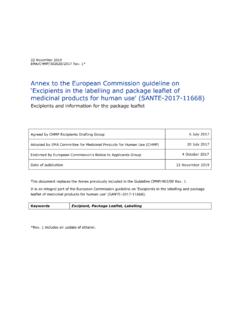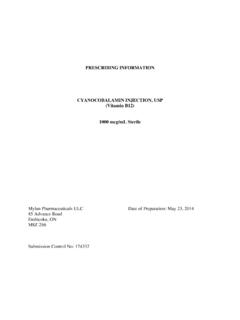Transcription of PRODUCT MONOGRAPH - Pr innohep®
1 Innohep (tinzaparin sodium) PRODUCT MONOGRAPH , version Page 1 of 34 PRODUCT MONOGRAPH Prinnohep tinzaparin sodium Sterile solution for SC injection Multi-dose vial 10,000 anti-Xa IU/mL 20,000 anti-Xa IU/mL Pre-filled syringe with safety needle device 2,500 anti-Xa mL 3,500 anti-Xa mL 4,500 anti-Xa mL 8,000 anti-Xa mL 10,000 anti-Xa mL 12,000 anti-Xa mL 14,000 anti-Xa mL 16,000 anti-Xa mL 18,000 anti-Xa mL Ph. Eur. Anticoagulant / Antithrombotic LEO Pharma Inc Thornhill, ON L3T 7W8 of Revision: Date of Approval: May 26, 2017 Submission Control No: 202366 Registered trademark of LEO Pharma A/S used under license by LEO Pharma Inc., Thornhill, ON innohep (tinzaparin sodium) PRODUCT MONOGRAPH , version Page 2 of 34 Table of Contents PART I: HEALTH PROFESSIONAL INFORMATION .. 3 SUMMARY PRODUCT INFORMATION .. 3 INDICATIONS AND CLINICAL USE.
2 3 CONTRAINDICATIONS .. 4 WARNINGS AND PRECAUTIONS .. 5 ADVERSE REACTIONS .. 12 DRUG INTERACTIONS .. 18 DOSAGE AND ADMINISTRATION .. 18 OVERDOSAGE .. 22 ACTION AND CLINICAL PHARMACOLOGY .. 23 STORAGE AND STABILITY .. 25 DOSAGE FORMS, COMPOSITION AND PACKAGING .. 25 PART II: SCIENTIFIC INFORMATION .. 27 PHARMACEUTICAL INFORMATION .. 27 DETAILED PHARMACOLOGY .. 28 TOXICOLOGY .. 30 REFERENCES .. 32innohep (tinzaparin sodium) PRODUCT MONOGRAPH , version Page 3 of 34 PrINNOHEP tinzaparin sodium PART I : HEALTH PROFESSIONAL INFORMATION SUMMARY PRODUCT INFORMATION Route of Administration Dosage Form / Strength Clinically Relevant Non-medicinal Ingredients Subcutaneous injection Sterile solution for injection: 10,000 anti-Xa IU/mL: Prefilled safety syringes* (preservative free): 2,500 IU ;3,500 and 4,500 mLMulti-dose vial (with preservative): 20,000 IU/2 mL 20,000 anti-Xa IU/mL: Prefilled safety syringes* (preservative free): 8,000 mL 10,000 mL; 12,000 mL; 14,000 mL; 16,000 mL; 18,000 IU/ mL Multi-dose vial (with preservative): 40,000 IU/2 mL The multi-dose vial contains sodium metabisulphite and benzyl alcohol.
3 The 8,000 IU, 10,000 IU, 12,000 IU, 14,000 IU, 16,000 IU and 18,000 IU pre-filled syringes contain sodium metabisulfite For a complete listing see Dosage Forms, Composition and Packaging section. *Pre-filled safety syringes have a 27-gauge (10,000 anti-Xa IU/mL and 20,000 anti-Xa IU/mL) or 29-gauge (20,000 anti-Xa IU/mL only), inch needle. All formats are latex free. anti-Xa IU abbreviated as IU INDICATIONS AND CLINICAL USE INNOHEP (tinzaparin sodium) is indicated for: The prevention of postoperative venous thromboembolism in patients undergoing orthopaedic surgery and inpatients undergoing general surgery who are at high risk of developing postoperative venous thromboembolism(see WARNINGS AND PRECAUTIONS, Peri-operative Considerations). The treatment of deep vein thrombosis and/or pulmonary (tinzaparin sodium) PRODUCT MONOGRAPH , version Page 4 of 34 The prevention of clotting in indwelling intravenous lines for haemodialysis and extracorporeal circulation in patients without high bleeding risk.
4 INNOHEP can not be used interchangeably, unit for unit, with unfractionated heparin or other low molecular weight heparins (LMWHs) (see WARNINGS AND PRECAUTIONS, General). Geriatrics: Close monitoring of elderly patients with low body weight ( , < 45 kg) and those predisposed to decreased renal function is recommended. (see WARNINGS AND PRECAUTIONS, Renal and Special Populations, Geriatrics). Pediatrics: The safety and effectiveness of INNOHEP in children has not been established. CONTRAINDICATIONS Hypersensitivity to INNOHEP (tinzaparin sodium); or any of its constituents, including benzyl alcohol (when using multi-dose vials) or sodium metabisulphite (see WARNINGS AND PRECAUTIONS); or to other LMWHs and/or heparin The multi-dose vials of INNOHEP contain 10 mg/mL benzyl alcohol as preservative and must not be given to children <3 years old, premature infants and neonates, due to the risk of developing gasping syndrome.
5 History of confirmed or suspected immunologically-mediated heparin-induced thrombocytopenia (delayed-onset severe thrombocytopenia), or in patients in whom an in vitro platelet-aggregation test in the presence of tinzaparin is positive Acute or subacute septic endocarditis Active major haemorrhage or conditions/diseases involving an increased risk of haemorrhage ( severe liver insufficiency, women with abortus imminens) Haemophilia or major blood clotting disorders Acute cerebral insults or haemorrhagic cerebrovascular accidents (except if there are systemic emboli) Active bleeding from a local lesion such as an acute ulcer ( , gastric or duodenal) or ulcerating carcinoma Uncontrolled severe hypertension Diabetic or haemorrhagic retinopathy Injury or surgery involving the brain, spinal cord, eyes or ears innohep (tinzaparin sodium) PRODUCT MONOGRAPH , version Page 5 of 34 Spinal/epidural anaesthesia requiring treatment dosages of INNOHEP (175 IU/kg once daily) due to anincreased risk of bleedingWARNINGS AND PRECAUTIONS General INNOHEP (tinzaparin sodium) must NOT be administered by intramuscular injection due to risk of hematoma.
6 Due to the risk of haematoma, concomitant intramuscular injections should also be avoided. INNOHEP cannot be used interchangeably (unit for unit) with unfractionated heparin or other LMWHs as they differ in their manufacturing process, molecular weight distribution, anti-Xa and anti-IIa activities, units and dosages. Special attention and compliance with instructions for use of each specific PRODUCT is required during any change in treatment. Determination of peak anti-Xa activity in plasma at 4-6 hours post-dosing is the only method available for monitoring tinzaparin levels. Routine clotting assays are not suitable for monitoring tinzaparin anticoagulant activity. APTT prolongation is not a suitable test for monitoring the LMWHs (see Monitoring and Laboratory Tests and ACTION AND CLINICAL PHARMACOLOGY). Cardiovascular Use in Patients with Prosthetic Heart Valves: Cases of prosthetic valve thrombosis have been reported in patients who received LMWHs for thromboprophylaxis.
7 Some of these patients were pregnant women in whom thrombosis led to maternal and/or fetal deaths. Pregnant women are at higher risk of thromboembolism (see Special Populations, Pregnant Women). Gastrointestinal INNOHEP should be used with caution in patients with a history of gastrointestinal ulceration. Hematologic innohep (tinzaparin sodium) PRODUCT MONOGRAPH , version Page 6 of 34 INNOHEP should not be used for the treatment of pulmonary embolism in patients with severe haemodynamic instability. Hemorrhage: Bleeding may occur in conjunction with unfractionated heparin or LMWH use. As with other anticoagulants, INNOHEP should be used with extreme caution in patients at increased risk of hemorrhage. Bleeding can occur at any site during therapy with INNOHEP. An unexpected drop in hematocrit or blood pressure should lead to a search for a bleeding site (see ADVERSE REACTIONS, Bleeding).
8 Post-Surgical Bleeding: As with all antithrombotic agents, there is a risk of systemic bleeding with INNOHEP. Care should be taken with INNOHEP use in high dose treatment of newly operated patients. In the event of excessive blood loss from the surgical wound, the first injection of INNOHEP should be deferred until the bleeding has stopped. After treatment is initiated, patients should be carefully monitored for bleeding complications. This may be done by regular physical examination of the patients, close observation of the surgical drain and periodic measurements of haemoglobin and anti-Xa determinations. In the case of minor bleeding, the drug should be postponed or withdrawn. When serious bleeding requires reversal of INNOHEP, protamine sulphate (1% solution) by slow infusion will largely neutralize INNOHEP (see OVERDOSAGE).
9 The effect of protamine sulphate should be monitored by the APTT. Thrombocytopenia: Thrombocytopenia of any degree should be monitored closely. Heparin-induced thrombocytopenia can occur with the administration of INNOHEP. Platelets: Platelet counts should be measured before the start of treatment and periodically thereafter. Regular monitoring of platelet counts also applies to extended treatment for cancer associated thrombosis. Platelet counts will usually normalise within 2 to 4 weeks after withdrawal. Caution is recommended when administering INNOHEP to patients with congenital or drug-induced thrombocytopenia or platelet defects. innohep (tinzaparin sodium) PRODUCT MONOGRAPH , version Page 7 of 34 During INNOHEP administration, special caution is necessary in rapidly developing thrombocytopenia and severe (NCI grade 3 or 4) thrombocytopenia (<50,000/mcL).
10 A positive or indeterminate result obtained from in vitro tests for antiplatelet antibody in the presence of tinzaparin or other LMWHs and/or heparin would contraindicate INNOHEP. Thrombocytosis: As with other LMWHs, the administration of INNOHEP in some patients undergoing surgical procedures (especially orthopaedic) or having a concomitant inflammatory process has coincided with an asymptomatic increase in platelet count. If an increase in platelet count occurs INNOHEP should be stopped, the benefit of continuing therapy for that patient should be re-evaluated against the risk. Hepatic INNOHEP should be used with caution in patients with hepatic insufficiency. Immune Sulphite Sensitivity: The overall prevalence of sulphite sensitivity in the general population is unknown. Sulphite sensitivity is seen more frequently in asthmatics than in non-asthmatic people.
![[Product Monograph Template - Standard]](/cache/preview/b/5/6/4/6/9/f/8/thumb-b56469f81fe4cee7737b379eed8967bf.jpg)




